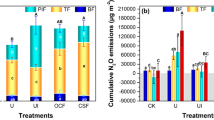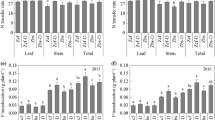Abstracts
Nitrogen (N) losses via nitrous oxide (N2O) emission, ammonia (NH3) volatilization and N leaching were investigated from N fertilizer applied to integrated rice–duck and rice–fish ecosystems in southern China. N2O emissions was measured by a static chambers technique, NH3 volatilization by a closed acid trap method, and N leaching by a field lysimeter. The experimental field was equally divided into nine plots for three different treatments: (1) conventional rice field (CK), (2) rice–duck ecosystem (RD) and (3) rice–fish ecosystem (RF). N2O emissions from fertilizer was affected by fertilization and drainage of paddy fields. RD significantly increased N2O emissions while RF decreased N2O emissions. N losses via N2O emissions in CK, RD and RF were 1.94, 2.19 and 1.91 kg N/ha, respectively. N losses via NH3 volatilization in CK, RD and RF were 46.30, 43.09 and 44.89 kg N/ha, respectively. Due to the presence of ducks and fish, RD and RF decreased N losses via NH3 volatilization and leakage of \({\text{NO}}_{\text{3}}^ - \) and total N. N losses via \({\text{NO}}_{\text{3}}^ - \) leaching in CK, RD and RF were 2.83, 2.57 and 2.45 kg N/ha, respectively, and N losses via total N leaching were 6.73, 6.11 and 5.81 kg N/ha, respectively. Analysis of total N losses via N2O emission, NH3 volatilization and N leaching indicated that total N losses in RD and RF were 51.39 and 52.60 kg N/ha, respectively, which were lower than that (54.97 kg N/ha) in CK, suggesting that the presence of ducks and fish could decrease N fertilizer loss rates, and thus promote N fertilizer use efficiency.





Similar content being viewed by others
Abbreviations
- CK:
-
Conventional rice field
- RD:
-
integrated rice–duck ecosystems
- RF:
-
integrated rice–fish ecosystems
- TN:
-
total N
References
Bijay-Singh, Yadbinder-Singh, Khind CS, Meelu OP, Singh B, Singh Y (1991) Leaching losses via urea-N applied to permeable soils under lowland rice. Fertil Res 28:179–184
Bronson KF, Neue HU, Singh U, Abao EBJ (1997) Automated chamber measurement of methane and nitrous oxide flux in a flooded rice soil: I. Residue, nitrogen, and water management. Soil Sci Soc Am J 61:981–987
Cai GX, Zhu ZL, Trevitt ACF, Freney JR, Simpson JR (1986) Nitrogen loss from ammonium bicarbonate and urea fertilizers applied to flooded rice. Fertil Res 10:203–215
Cai GX, Chen DL, Ding H, Pacholski A, Fan XH, Zhu ZL (2002) Nitrogen losses from fertilizers applied to maize, wheat and rice in the North China Plain. Nutr Cycl Agroecosyst 63:187–195
Chauhan HS, Mishra B (1989) Ammonia volatilization from a flooded rice field fertilized with amended urea materials. Fertil Res 19:57–63
Choudhury ATMA, Kennedy IR (2005) Nitrogen fertilizer losses from rice soils and control of environment pollution problems. Commun Soil Sci Plant Anal 36:1625–1639
Conrad R (1996) Metabolism of nitric oxide in soil and soil microorganisms and regulation of flux into the atmosphere. In: Murrell JC, Donovan PK (eds) Microbiology of atmospheric trace gases, NATO ASI Series, vol. I 39. Spring, Berlin, pp 167–203
Crill PM, Bartlett KB, Harriss RC, Gorham E, Verry ES, Sebacher DI, Madzer L, Sanner W (1988) Methane flux from Minnesota peatlands. Glob Biogeochem Cycles 2:371–384
Ekurem E, Ryohei Y (1996) Comparative studies on behavior, weeding and pest control of duck free ranged in paddy fields. Jpn Poult Sci 33:261–267
FAO (1998) Fertilizer. FAO yearbook Vol. 48
Frei M, Becker K (2005a) Integrated rice–fish culture: coupled production saves resources. Nat Resour Forum 29:135–143
Frei M, Becker K (2005b) Integrated rice–fish production and methane emission under greenhouse conditions. Agric Ecosyst Environ 107:51–56
Frei M, Becker K (2005c) A greenhouse experiment on growth and yield effects in integrated rice–fish culture. Aquaculture 244:119–128
Frei M, Khan MAM, Razzak MA, Hossain MM, Dewan S, Becker K (2007a) Effects of a mixed culture of common carp, Cyprinus carpio L., and Nile tilapia, Oreochromis niloticus (L.), on terrestrial arthropod population, benthic fauna, and weed biomass in rice Welds in Bangladesh. Biol Control 41:207–213
Frei M, Razaak ma, Hossain MM, Oehme M, Dewan S, Becker K (2007b) Performance of common carp, Cyprinus carpio L. and Nile tilapia, Oreochromis niloticus (L.), in integrated rice–fish culture in Bangladesh. Aquaculture 262:250–259
Gupta MV, Sollows MA, Mazid A, Rahman MG, Hussain MG, Dey MM (1998) Integrating aquaculture with rice farming in Bangladesh: feasibility and economic viability, its adoption and impact. ICLARM Tech. Rep.55, p 90
Halwart M (1994) Fish as biological control agents in rice. Margraf Verlag, Weikerskeim Germany, p 169
Huang M, Huang H, Gan DX (2003) Study on application duck-culturing technique to no-tillage cast-transplant. J Hunan Agric Uni 29:207–210
Huang Y, Wang H, Huang H, Feng ZW, Yang ZH, Luo YC (2005) Characteristics of methane emission from wetland rice–duck complex ecosystem. Agric Ecosyst Environ 105:181–193
Jagadeesh BY, Li C, Frolking S, Nayak DR, Adhy TK (2006) Field validation of DNDC model for methane and nitrous oxide emissions from rice-based production systems of India. Nutr Cycl Agroecosyst 74:157–174
Kreye C, Dittert K, Zheng XH, Zhang X, Lin S, Ta HB, Sattelmacher B (2007) Fluxes of methane and nitrous oxide in water-saving rice production in north China. Nutr Cycl Agroecosys 77:293–304
Lightfoot C, van Dam A, Costa-Pierce B (1992) What’s happening to rice yields in rice–fish systems? In: dela Cruz CR, Lightfoot C, Costa-Pierce BA, Carangal VR, Bimbao MP (eds) Rice–fish research and development in Asia. ICLARM. Conference Proceedings, pp 245–254
Liu XY, Yang ZP, Huang H, Hu LD, Liu DZ, Tan SQ, Su W (2004) A study on the sheath blight’s developing rules in rice–duck compounded ecosystem of wetland. Acta Ecol Sinica 24:2579–2583
Lu JB, Li X (2006) Review of rice–fish-farming systems in China—one of the globally important ingenious agricultural heritage systems (GIAHS). Aquaculture 260:16–113
Mailhol JC, Ruelle P, Nemeth I (2001) Impact of fertilisation practices on nitrogen leaching under irrigation. Irrig Sci 20:139–147
Malla G, Bhatia A, Pathak H, Prasad S, Jain N, Singh J (2005) Mitigating nitrous oxide and methane emissions from soil in rice–wheat system of the Indo-Gangetic plain with nitrification and urease inhibitors. Chemosphere 58:141–147
Oehme M, Frei M, Razzak MA, Dewan S, Becker K (2007) Studies on nitrogen cycling under different nitrogen inputs in integrated rice–fish culture in Bangladesh. Nutr Cycl Agroecosyst 79:181–191
Panda MM, Ghosh BC, Sinhababu DP (1987) Uptake of nutrients by rice under rice-cum-fish culture in intermediate deep water situation (up to 50-cm depth). Plant Soil 102:131–132
Panda D, Mahata KR, Sen HS, Patnaik S (1989) Transformation and loss via nitrogen due to leaching and ammonia volatilization in wetland rice (Oryza sativa) soil. India J Agric Sci 59:291–136
Rochette P, van Bochove E, Prevost D, Angers DA, Cote D, Bertrand N (2000) Soil carbon and nitrogen dynamics following application of pig slurry for the 19th consecutive year. II. Nitrous oxide fluxes and mineral nitrogen. Soil Sci Soc Am J 64:1396–1403
SEPA (2002) Methods for examination of water and wastewater. China Environmental Science Press, Beijing, pp 246–248
Singh JS, Sing S, Raghubanshi AS, Singh S, Kashyap AK (1996) Methane flux from rice/wheat agroecosystem as affected by crop phenology, fertilization and water lever. Plant Soil 183:323–327
Smith KA (1997) The potential for feedback effects induced by global warming on emissions of nitrous oxide by soils. Glob Chang Biol 3:327–338
Song YS, Fan XH, Lin DX, Yang LZ, Zhou JM (2004) Ammonia volatilization from paddy fields in the Taihu lake region and its influencing factors. Acta Pedologica Sinica 41(2):265–269
Suratno W, Murdiyarsob D, Suratmoc FG, Anas I, Saenic MS, Rambec A (1998) Nitrous oxide flux from irrigated rice fields in West Java. Environ Pollut 102(Sl):159–166
Tsuruta H, Kanda K, Hirose T (1997) Nitrous oxide emission from a rice paddy field in Japan. Nutr Cycl Agroecosyst 49:51–58
Vlek PLG, Byrens BH (1986) The efficacy and loss via fertilizer N in lowland rice. Fertil Res 9(1–2):131–147
Vlek PLG, Diakite MY, Mueller H (1995) The role of Azolla in curbing ammonia volatilization from flooded rice systems. Fertil Res 42:165–174
Vromant N, Chau NTH, Ollevier F (2001) The effect of rice-seeding rate and fish stocking on the floodwater ecology of the trench of a concurrent, direct-seeded rice–fish system. Hydrobiologia 457:105–117
Wang Y (2000) Studies on ecological benefits of planting and breeding model in rice fields. Acta Ecol Sinica 20(2):311–316
Wang H, Huang H (2002) Analysis on ecological and economic benefits of complex ecosystem in wetland paddy fields. Chin Agric Sci Bull 18(1):71–75
Wang H, Huang H, Yang ZH, Liao XL (2003) Integrated benefits of rice–duck complex ecosystem. Rural Eco-Environ 19:23–26
Wang H, Yang JP, Jin J, Sun JH (2006a) N variation in rice–soil–water system under different N application level in high-yielding paddy field and its environment effect. J Soil Water Conserv 20(1):50–54
Wang JP, Cao CG, Jin H, Liu FH (2006b) Effects of rice–duck farming on aquatic community in rice fields. Sci Agric Sinica 39(10):2001–2008
Weeraratna CS, Craswell ET (1985) Nitrogen losses from labelled ammonium sulphate and urea applied to a flooded rice soil. Fertil Res 6:199–203
Xie LQ, Chen SG, Liao XL, Luo K, Tong ZX, Chen WJ (2005) Ecological and economical effect of rice–duck complex system. Hunan Agr Sci 4:93–95
Xiong ZQ, Xing GX, Zhu ZL (2007) Nitrous oxide and methane emissions as affected by water, soil and nitrogen. Pedosphere 17(2):146–155
Yang ZP, Liu XY, Huang H, Liu DZ, Hu LD, Su W, Tan SQ (2004) A study on the influence of rice–duck intergrowth on spider, rice diseases, insect and weeds in rice–duck complex ecosystems. Acta Ecol Sinica 24:2756–2760
Yang Y, Zhang HC, Hu XJ, Dai QG, Zhang YJ (2006) Characteristics of growth and yield formation of rice in rice–fish farming system. Sci Agric Sinica 5(2):103–110
Yu SM, Ouyang YN, Zhang QY, Peng G, Xu DH, Jin QY (2005) Effects of rice–duck farming system on Oryza sativa growth and its yield. Chin Appl Ecol 16(7):1252–1256
Yuan XQ (1992) Role of fish in pest control in rice farming. In: dela Cruz CR, Lightfoot C, Costa-Pierce BA, Carangal VR, Bimbao MP (eds) Rice–fish research and development in Asia. ICLARM. Conference Proceedings, pp 235–243
Zheng YH, Deng GB, Lu GM (1997) Eco-economic benefits of rice–fish–duck complex ecosystem. Chin Appl Ecol 8(4):431–434
Zheng XH, Wang MX, Wang YS, Shen RX, Li J (1998) Comparison of manual and automatic methods for measurement of methane emission from rice paddy fields. Adv Atmos Sci 15(4):569–579
Zhu JG, Han Y, Liu G, Zhang YL, Shao XH (2000) Nitrogen in percolation water in paddy fields with a rice/wheat rotation. Nutr Cycl Agroecosyst 57:75–82
Acknowledgement
This research was funded by National Foundation of Key Science of China (No. 2004BA520A02).
Author information
Authors and Affiliations
Corresponding author
Additional information
Responsible Editor: Bernard Nicolardot.
Rights and permissions
About this article
Cite this article
Cheng-fang, L., Cou-gui, C., Jin-ping, W. et al. Nitrogen losses from integrated rice–duck and rice–fish ecosystems in southern China. Plant Soil 307, 207–217 (2008). https://doi.org/10.1007/s11104-008-9597-1
Received:
Accepted:
Published:
Issue Date:
DOI: https://doi.org/10.1007/s11104-008-9597-1




